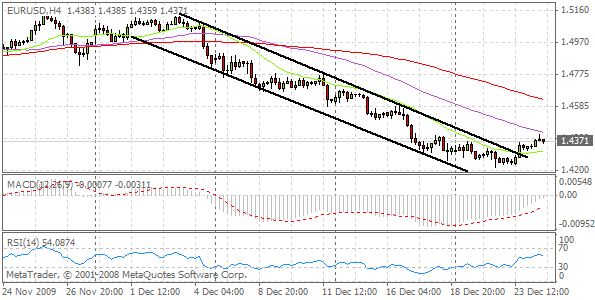Source: ForexYard
With a slow trading day expected today, investors will likely keep there eyes on the U.S. Dollar and whether it can maintain its recent upswing going into the New Year. Set to be released later today, the U.S. Consumer Confidence report should give traders a good idea about the general direction of the greenback as 2009 draws to a close.
Economic News
USD – Consumer Confidence Report Likely to Impact Greenback
Light trading on Monday, mainly due to low liquidity in the market, gave the Dollar a slight advantage over its major counterparts. After breaching the 1.4400 level against the Dollar yesterday, the Euro subsequently fell and is currently trading at the 1.4365 level. Against the Yen, the greenback advanced slightly, and is now trading around the 91.75 level.
Traders should note that most analysts do not see these Dollar increases as signs of a continued trend. With many investors on vacation for the holidays, USD gains may have just been a result of low liquidity and a slow news day on Monday. Traders will want to pay attention to the U.S. Consumer Confidence report set to be released at 15:00 GMT today.
A higher number then last month is forecasted for the report, which if indeed comes true, will likely support the Dollar. Most analysts are saying that the American people are slowly regaining faith in the U.S. economy. If the consumer confidence figure reflects that sentiment, it could be an early sign as to where the Dollar is headed in 2010.
EUR – Euro Slips against Major Currencies
The U.S. Dollar was not the only currency to see gains against the Euro in the last 24 hours. The Canadian Dollar rallied against the Euro in early morning trading and even hit its highest level since November 2008, at 1.4977. The pair has since corrected itself and has currently returned to its normal levels of around 1.4990. Still, traders may want to keep an eye out for any unusual activity from this pair. It appears that exciting things can happen on the market despite slow trading.
Despite a predicted slow news day for the Euro today, there are still a few things that may inject some volatility into the market. Chief among these is the German Prelim CPI, the Euro-Zone’s earliest consumer inflation report. Consumer inflation can play a direct role in interest rate levels which directly impact currency values. With a forecasted increase of 0.6%, the Euro may receive a much needed boost providing the predictions are correct.
Traders may want to take into account the results of the German Prelim CPI when looking at the U.S. Consumer Confidence report. If both come out as predicted, the EUR/USD pair may take some interesting turns in trading today.
JPY – Yen Sinks against Dollar
Early morning trading saw the Yen drop to a 5-day low against the U.S. Dollar, reaching 91.79. The Dollar appears to be finishing 2009 with a 1% gain against the Yen, a far cry from the roughly 19% loss recorded in 2009. The greenback may see further gains against the Yen in trading today, providing that U.S. consumer confidence increases as expected. If not, the JPY may be able to reverse some of its recent losses.
With no major news events coming out of Japan for the rest of the week, the Yen’s value will likely be influenced by news from America and Europe. The relatively slow trading ahead of the New Year appears to be negatively impacting the Yen, but traders should note that any negative economic indicator to come out of Europe or the U.S. will likely result in Yen gains.
Crude Oil – Oil Prices Up Ahead of New Year
Crude oil prices rose to a near 5-week high on Monday, trading at $78.73 at the close of the market amid optimism of the global economic recovery. Prices have since dropped to around $78.45, but could easily gain traction again after the release of the U.S. Consumer Confidence report. A positive figure from the report would likely increase investor confidence, thereby boosting prices.
Several other news events may also be impacting oil prices. Political unrest in Iran, the world’s second largest Oil producer, appears to have driven prices up. Furthermore, severe winter weather in the U.S., the world’s largest Oil consumer, has caused Oil consumption to rise, which has also caused prices to rise. With a slow trading week for currencies, it appears that Crude Oil may be injecting some much desired volatility in the market.
Technical News
EUR/USD
The daily chart’s RSI is floating in the oversold territory with the MACD exhibiting an impending bullish cross. Going long for the day may be advised.
GBP/USD
The pair seems to be exhibiting some mixed signals with the 2 hour RSI floating in the overbought territory and the 4 hour’s Slow Stochastic is showing a bearish cross. However, the daily RSI is floating in the oversold territory. Going short with tight stops might be advised for today.
USD/JPY
The pair may experience a downward correction today as the hourly, 2 hour and 4 hour RSI is floating in the overbought territory, with the daily chart’s Slow Stochastic exhibiting a bearish cross. Going short for the day may be advised.
USD/CHF
It appears as the pair’s downward trend is likely to continue as the 2 hour chart’s Slow Stochastic as well as the daily MACD are exhibiting fresh bearish crosses. Going short for the day may be advised.
The Wild Card – GBP/CAD
The pair’s recent bearish trend may be experiencing a correction soon as the 8 hour and daily RSI is floating in the oversold territory and the daily chart’s Slow Stochastic is exhibiting a bullish cross. The 8 hour MACD is also exhibit an impending bullish cross. Forex traders may be advised to go long for the day.
Forex Market Analysis provided by Forex Yard.
© 2006 by FxYard Ltd
Disclaimer: Trading Foreign Exchange carries a high level of risk and may not be suitable for all investors. There is a possibility that you could sustain a loss of all of your investment and therefore you should not invest money that you cannot afford to lose. You should be aware of all the risks associated with Foreign Exchange trading.









